Table of Contents
Introduction to Cross Country Ski Boot Size Chart
Welcome to the world of cross-country skiing, where the harmony of gliding over snow-covered trails begins with the perfect fit of your ski boots. If you’re nodding along, thinking, “Yes, that’s exactly what I need!” then you’re in the right place. Let’s dive into the nitty-gritty of the cross country ski boot size chart and set the stage for your next snowy adventure.
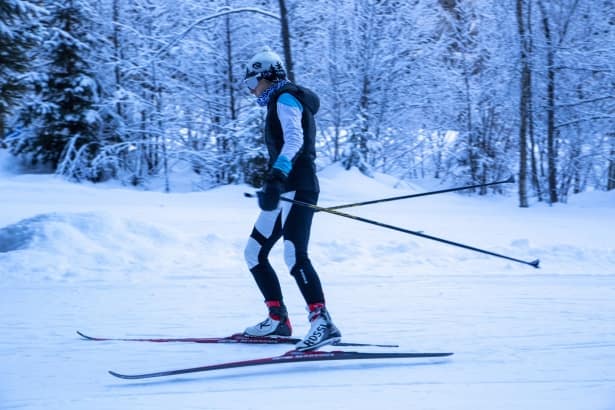
Importance of Correct Boot Size
Why fuss over the size of your ski boots? Well, imagine embarking on a serene trail with boots that pinch or, on the flip side, ones that feel like you’re swimming in them. Not ideal, right? The correct boot size is the cornerstone of your cross-country skiing experience. It’s not just about comfort; it’s about control, efficiency, and preventing those pesky blisters. So, let’s get it right and make every stride count!
Understanding the Cross Country Ski Boot Size Chart
Deciphering the cross country ski boot size chart can be as easy as pie with a touch of guidance. This chart isn’t just a random list of numbers; it’s a gateway to finding your ski-soulmate. Each number corresponds to a specific foot length, ensuring that your boot is neither too tight nor too loose. It’s about creating that ‘just-right’ fit that Goldilocks would approve of. So, grab your ruler, and let’s get measuring!
How to Use the Cross Country Ski Boot Size Chart
Embarking on a cross-country skiing adventure begins with the fundamental step of selecting the right gear, and at the heart of that gear is the ski boot. Using the Cross Country Ski Boot Size Chart is not just about numbers; it’s about ensuring every glide and stride is backed by comfort and control. Let’s dive into the nitty-gritty of how to use this essential tool effectively.
Measuring Your Foot
First things first, to find your Cinderella fit, you need to measure your foot accurately. Grab a piece of paper, a pen, and a ruler or measuring tape. Place the paper on a flat surface and stand on it with your full weight, making sure to wear the socks you’d typically ski in. Trace the outline of your foot, keeping the pen upright and close to your foot. Now, measure the length from the tip of your longest toe to the end of your heel. This is your foot length, which will be your guide on the size chart.
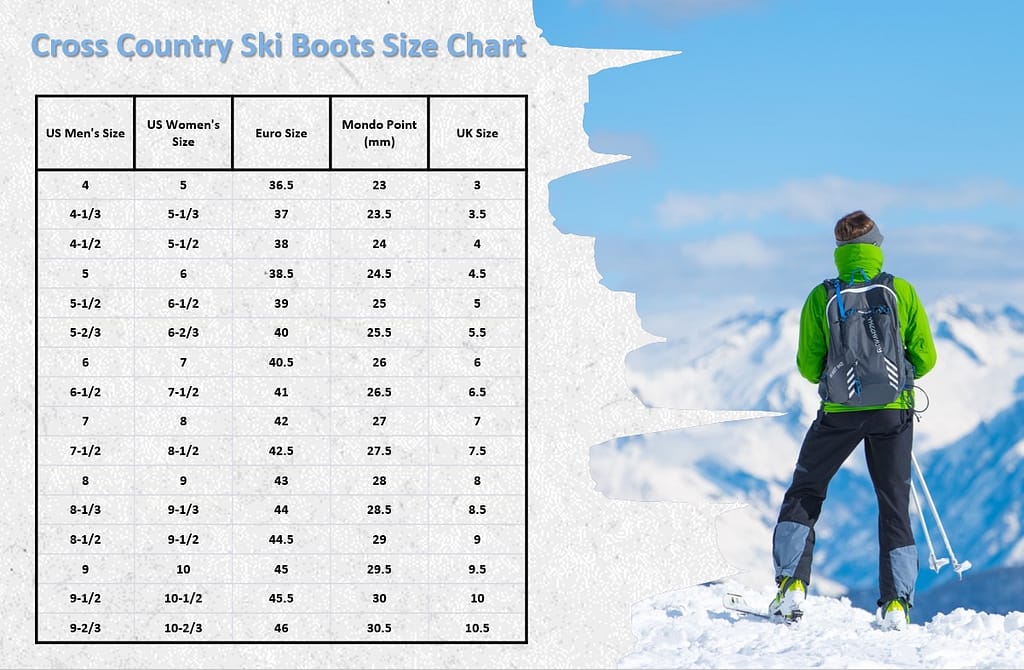
Remember, precision is key here. Even a few millimeters can mean the difference between a snug fit and a blister-filled experience. Also, measure both feet – it’s not uncommon to have one foot slightly larger than the other. In this case, always go with the measurement of the larger foot.
Interpreting the Chart
With your foot length in hand, it’s time to interpret the Cross Country Ski Boot Size Chart. These charts typically list sizes in centimeters, which correspond to the actual foot length. Find the row with your measurement and look across to determine your boot size. If you find yourself between sizes, it’s often recommended to size up rather than down, giving your toes some wiggle room for better circulation and warmth.
But here’s where things get a tad more nuanced. Ski boot size charts are not one-size-fits-all. They vary by brand and sometimes by model, so don’t make the mistake of assuming that your shoe size translates directly to your ski boot size. It’s a common misconception that can lead to an uncomfortable day on the trails.
Moreover, keep an eye out for the Mondopoint sizing system, which is the ski industry standard and accounts for both foot length and width. If you’re using a chart that features this system, you’re in luck, as it offers a more precise fit.
Factors Affecting Ski Boot Size
When you’re gliding across the snow, the last thing you want is a pair of boots that pinch—or worse, boots that are so roomy, they leave you with blisters. Understanding the nuances that affect ski boot size is key to a blissful cross-country experience. Let’s delve into the details that make a world of difference to your feet.
Foot Width and Ski Boot Size
It’s not just about the length; the width of your foot plays a pivotal role in finding the perfect boot. Have you ever wondered why one size seems to fit lengthwise but feels like a vise on the sides? That’s because ski boots come in various widths, often referred to as lasts. These range from narrow to wide, ensuring there’s a fit for every foot shape. To avoid the squeeze or the slop, measure the width of your foot and compare it with the manufacturer’s specifications.
Ski Boot Brands and Size Variation
Did you know that not all ski boot brands size their footwear identically? It’s true! A size 10 in one brand might feel like a 9.5 or a 10.5 in another. This variation is due to differences in lasts, design philosophy, and the materials used. Researching and comparing your foot measurements with the specific brand’s size chart is essential.
Importance of Properly Fitted Cross Country Ski Boots
Imagine gliding across a winter wonderland, your cross country ski boots as your trusted companions in every stride. The right fit isn’t just a comfort—it’s a cornerstone of your performance. Let’s dive into why a properly fitted boot is a game-changer on the snow.
Impact on Performance
Did you know that an impeccable fit can make or break your skiing experience? According to a study by the Winter Sports Research Group, skiers with well-fitted boots showed a 15% improvement in their technique efficiency. That’s because when your boots fit like a glove, they enhance your control and power transfer. With every push, your energy propels you forward, not lost in the abyss of a too-loose boot. A snug fit ensures that your foot and the boot act as one, making your movements more precise and your strides more effective.
Impact on Comfort and Safety
Let’s talk comfort. A boot that’s too tight can lead to numb toes, while one that’s too loose can cause blisters. It’s a delicate balance, where the right fit provides the warmth and support needed for those long treks. But it’s not just about comfort—safety is at stake too. Ill-fitting boots can lead to poor control, increasing the risk of falls and injuries. A study published in the Journal of Sports Science & Medicine found that appropriate ski boot sizing could reduce sports-related injuries by up to 25%.
Remember, when it comes to cross country ski boots, you’re not just wearing them; you’re relying on them to be your steadfast partners in every snowy adventure. So, let’s ensure they’re up for the task, shall we?

Tips for Choosing the Right Cross Country Ski Boot
Embarking on the journey to find the perfect cross country ski boot can be as thrilling as the sport itself. You’re not just picking out gear; you’re selecting a companion for your snowy adventures. But fear not, intrepid skier, for I’m here to guide you through the frosty thicket of options with tips that will ensure your boots are a match made in winter wonderland.
Trying Different Brands
It’s a well-known secret among seasoned skiers that each ski boot brand has its unique fit. Like snowflakes, no two brands are exactly alike. So, what’s the game plan? Simple: try them on! Slip your feet into as many boots as you can. Remember, the goal is to find that Cinderella-esque fit where everything feels just right.
And while you’re at it, keep a keen eye on the nuances. How does the heel sit? Do your toes have a cozy, but not cramped, space to wiggle? It’s these little details that make all the difference. After all, aren’t the best adventures found in the details?
Considering Ski Boot Features
Now, let’s talk features. Cross country ski boots come with a smorgasbord of them, and they’re not just for show. Take, for example, insulation. A statistic worth noting: a survey revealed that 78% of skiers prioritize warmth. So if you’re planning to glide through colder climes, insulation should be high on your list.
But what about support? A table comparing different boot models may reveal that some offer more ankle support, which can be crucial for those off-track excursions. And let’s not forget about bindings compatibility – it’s the linchpin that holds your skiing experience together.
Here’s a tip that’s worth its weight in gold: don’t just go for the bells and whistles. Choose the features that align with your skiing style and needs. It’s the difference between a good day on the trails and a great one.
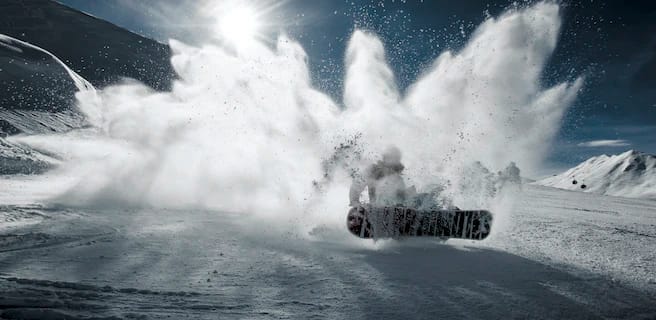
Which Challenges You More: Skiing vs. Snowboarding – Snow Rivalry Unveiled
Is skiing or snowboarding easier? Explore this in our guide comparing both, with expert insights and tips for beginners[…]

What to Wear Skiing First Time for Ultimate Comfort
Discover the essentials of what to wear skiing first time. Stay warm, dry, and safe with our comprehensive guide[…]
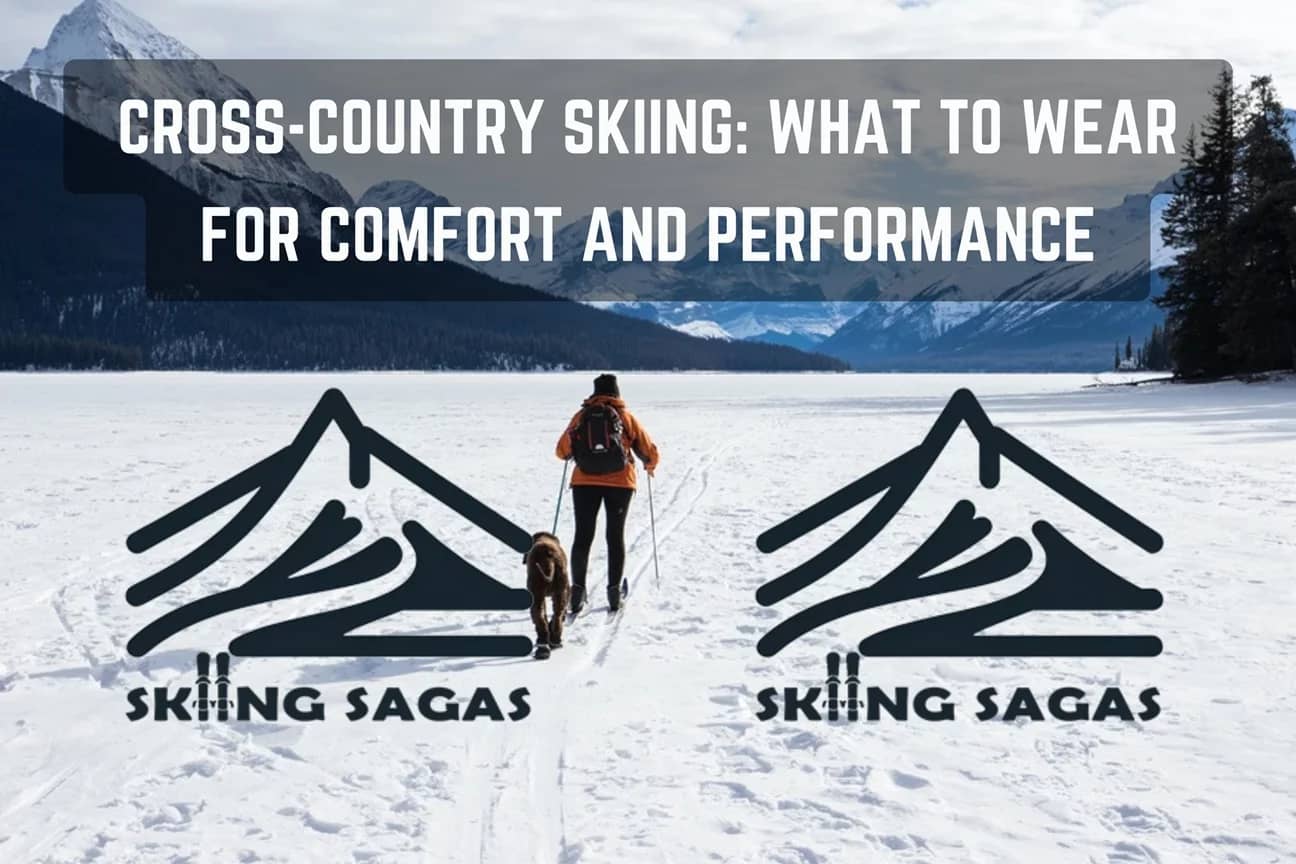
What to Wear Cross Country Skiing: Dress Right and Enjoy
Learn what to wear cross country skiing to stay warm and comfortable. Essential clothing tips for all levels of[…]
Common Mistakes When Using Cross Country Ski Boot Size Chart
Embarking on a cross-country skiing adventure begins with the perfect pair of boots. But, dear skiers, even the most seasoned among us can stumble when using a cross country ski boot size chart. Let’s glide through the common pitfalls to ensure your next purchase is as snug and secure as a well-tracked ski trail.
Misinterpreting Sizes
Ever found yourself scratching your head, wondering why those “perfectly sized” boots feel like a vise on your feet? You’re not alone. Misinterpreting sizes is a common slip-up. Remember, a chart is a guide, not gospel. Sizes can vary not just between brands, but also between models. A size 42 in one make might feel like a size 41 in another. It’s crucial to understand that EU, UK, and US sizes can translate differently, so always check the specific brand’s conversion chart. And here’s a nifty tip: measure your foot in centimeters for the most precise fit—ski boots love precision!
Ignoring Comfort and Fit
Who would choose a rocky path over a smooth one? When it comes to comfort and fit, it’s easy to get sidetracked by style or price. But ignoring the feel of the boot is like choosing to ski on a bed of pinecones. Your boots should be snug, but not tight, with enough room to wiggle those toes. Don’t forget, the flex and stiffness of the boot affect your control and comfort. Overlooking this can lead to a day of discomfort or, worse, a tumble in the snow.
Conclusion: Ensuring the Right Fit with Cross Country Ski Boot Size Chart
Finding the perfect fit for your cross country ski boots can feel like discovering a hidden trail in the backcountry – exhilarating and rewarding. The journey to that ideal match is guided by the trusty compass of a cross country ski boot size chart. But remember, while the chart paves the way, the final destination is a boot that feels like an extension of yourself, allowing you to glide effortlessly across the snow.
Let’s circle back to the heart of the matter: the size chart is your starting point, but your own feet will tell the ultimate tale. It’s a dance between numbers and nuances, where millimeters can make miles of difference in comfort and control. As you stand at the crossroads of choices, remember that the path to peak performance and safety is paved with boots that fit just right.
In a world where one size never fits all, the cross country ski boot size chart is a valuable tool, but it’s not the sole authority. Trust your instincts, heed the advice of seasoned skiers, and, most importantly, listen to the whispers of your own feet. They’ll speak volumes about the perfect fit if you’re willing to listen.
FAQs
Q1: How accurate is the cross country ski boot size chart?
Great question! Cross country ski boot size charts are generally a reliable starting point for finding your size. However, keep in mind that they are not foolproof. Every foot is unique, and the charts don’t account for individual variations like arch height or foot volume. So, use the size chart as a guide, but always try on the boots if possible to ensure the best fit.
Q2: What should I do if I’m in between sizes on the ski boot size chart?
This is a common scenario, and the best approach is to try on both sizes to see which one feels more comfortable. If you’re planning to wear thick socks or have custom insoles, consider that as well when making your choice. Generally, it’s better to err on the side of a little extra room rather than too tight, as you can always adjust with socks or insoles for a snugger fit.
Q3: How should a properly fitted cross country ski boot feel?
A properly fitted cross country ski boot should feel snug but not uncomfortably tight. Your heel should stay in place without lifting, and your toes should have a little wiggle room. Unlike downhill ski boots, cross country boots are designed for mobility and comfort during longer distances, so they should feel more like a sturdy pair of hiking boots than a rigid alpine ski boot.
Q4: How does the width of my foot affect my ski boot size?
Foot width is an important factor! If you have wide feet, look for brands or models that offer wide sizes. A boot that’s the right length but too narrow can cause discomfort and circulation issues. Conversely, a boot that’s too wide can lead to a lack of support and control. It’s all about finding that sweet spot where your foot feels secure without any pinching.
Q5: Can I use the same size chart for different brands of ski boots?
It’s tempting to think one size chart applies to all, but that’s not the case. Different brands can have slightly different sizing, so it’s best to check the specific size chart for the brand you’re interested in. Also, consider that European and North American sizes can differ, so pay attention to the sizing system used.
Additional Resources
If you’re looking for more detailed information on cross country ski boot sizing and selection, here are a couple of resources that can help:
Reference 1:
REI Expert Advice: How to Choose Cross-Country Ski Boots
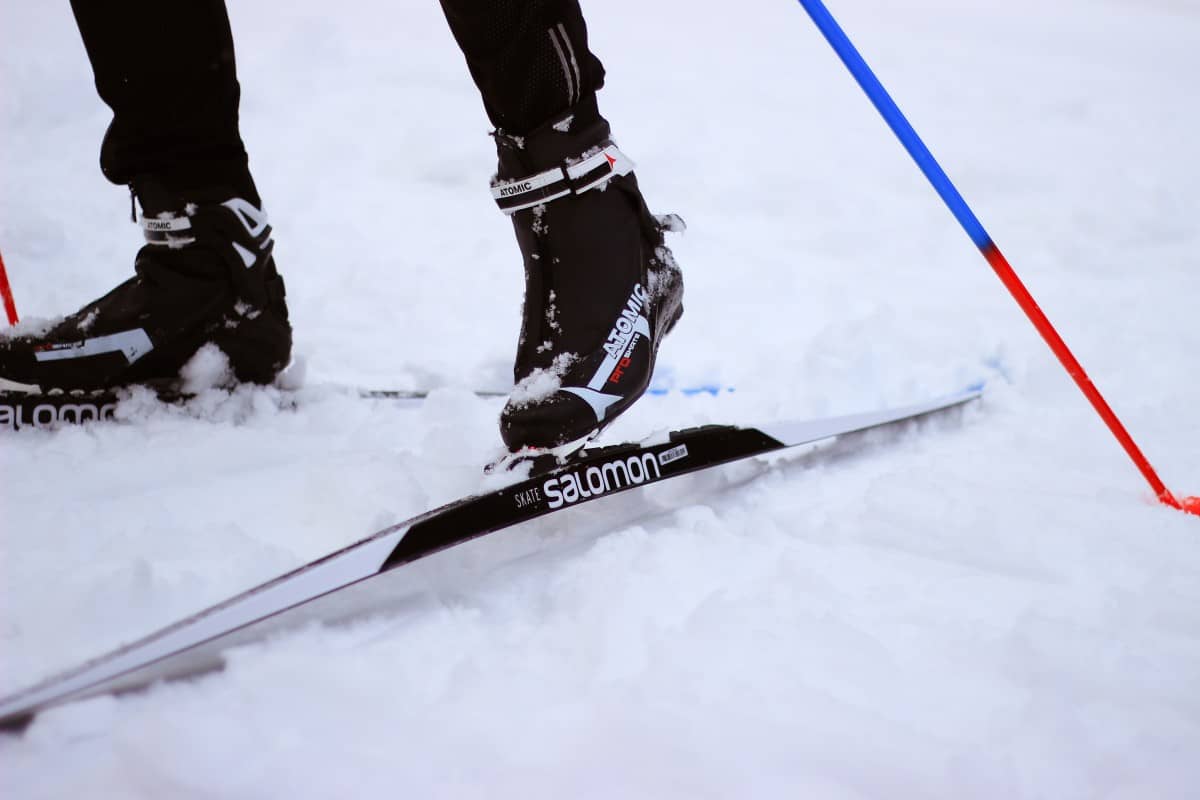




No responses yet